Dual-Temperature Evaluation of a High-Temperature Insulation System for Liquid-Immersed Transformer
Abstract
:1. Introduction
2. Experimental Methods
2.1. Materials
2.2. Dual-Temperature Thermal Aging Platform
2.3. Sample Pretreatment
2.4. Thermal Aging Test Conditions: Temperature and Aging Period
3. Aging Test Results of Insulating Papers
3.1. Tensile Strength of Insulating Papers
3.2. Thermal Index (TI) of Insulation Systems
3.3. Dielectric Strength of Insulating Paper
4. Aging Test Results of Insulating Oils
4.1. Water Content
4.2. Dynamic Viscosity
4.3. Total Acidity
4.4. Breakdown Voltage
5. Conclusions
Author Contributions
Funding
Acknowledgments
Conflicts of Interest
References
- State Grid Corporation of China. Technical Guide for High Overload Capacity Distribution Transformer of Rural Power Network; Q/GDW 11190:2014; China Electric Power Press: Beijing, China, 2015. [Google Scholar]
- China Southern Power Grid. Technical Guidance of 10 kV Over-Loading Fluid Filled Transformer; China Southern Power Grid: Guangzhou, China, 2015. [Google Scholar]
- Cigre Working Group TF D1.01.10. Aging of Cellulose in Mineral-Oil Insulated Transformers; International Council on Large Electric Systems: Paris, France, 2007. [Google Scholar]
- Frimpong, G.K.; Oommen, T.V. A survey of aging characteristics of cellulose insulation in natural ester and mineral oil. IEEE Electr. Insul. Mag. 2011, 27, 36–48. [Google Scholar] [CrossRef]
- Yang, L.; Liao, R.; Sun, C. Influence of vegetable oil on the thermal aging rate of Kraft paper and its mechanism. In Proceedings of the 2010 International Conference on High Voltage Engineering and Application (ICHVE), New Orleans, LA, USA, 11–14 October 2010. [Google Scholar]
- McShane, C.P.; Rapp, K.J.; Corkran, J.L. Aging of paper insulation in natural ester dielectric fluid. In Proceedings of the 2001 IEEE/PES Transmission and Distribution Conference and Exposition, Atlanta, GA, USA, 2 November 2001. [Google Scholar]
- Lee, K.; Szewczyk, R.; Zhou, Y. A new insulation system for liquid-immersed distribution transformers. In Proceedings of the 5th European Conference on HV & MV Substation Equipments Power Utilities (MATPOST 2015), Lyon, France, 24–25 November 2015. [Google Scholar]
- Zhang, X.; Shen, S.; Xu, Y. Thermal Evaluation of High-Temperature Insulation System for liquid-immersed transformer. In Proceedings of the IEEE Electrical Insulation Conference (EIC 2016), Montreal, QC, Canada, 19–22 June 2016. [Google Scholar]
- IEEE C57.100 Working Group. IEEE Standard Test Procedure for Thermal Evaluation of Insulation Systems for Liquid-Immersed Distribution and Power Transformers; IEEE Std C57.100TM-2011 (Revision of IEEE Std C57.100-1999); IEEE: New York, NY, USA, 2011. [Google Scholar]
- International Electrotechnical Commission (IEC). Electrical Insulation Systems (EIS)—Thermal Evaluation of Combined Liquid and Solid Components—Part 2: Simplified Test; IEC TS 62332-2:2014; IEC: Geneva, Switzerland, 2014. [Google Scholar]
- International Electrotechnical Commission (IEC). Electrical Insulation Systems (EIS)—Thermal Evaluation of Combined Liquid and Solid Components—Part 1: General Requirements; IEC TS 62332-1:2011; IEC: Geneva, Switzerland, 2011. [Google Scholar]
- Wicks, R.C. Insulation system for liquid-immersed transformers—New materials require new methods for evaluation. In Proceedings of the IEEE Electrical Insulation Conference (EIC 2009), Montreal, QC, Canada, 31 May–3 June 2009. [Google Scholar]
- Xu, Y.; Qian, S. Oxidation Stability Assessment of a Vegetable Transformer Oil under Thermal Aging. IEEE Trans. Dielectr. Electr. Insul. 2014, 21, 683–692. [Google Scholar] [CrossRef]
- Lawson, W.G.; Simmons, M.A. Thermal Aging of Cellulose Paper Insulation. IEEE Trans. Dielectr. Electr. Insul. 1977, EI-12, 61–66. [Google Scholar] [CrossRef]
- Montsinger, V.M. Loading Transformers by Temperature. Trans. Am. Inst. Electr. Eng. 1930, 49, 776–790. [Google Scholar] [CrossRef]
- American Society for Testing and Materials International (ASTM International). Standard Test Method for Tensile Properties of Paper and Paperboard Using Constant-Rate-of-Elongation Apparatus; ASTM D828-16; ASTM International: West Conshohocken, PA, USA, 2016. [Google Scholar]
- International Electrotechnical Commission (IEC). Electrical Insulation Materials—Thermal Endurance Properties—Part 3: Instructions for Calculating Thermal Endurance Characteristics; IEC TS 60216-3:2009; IEC: Geneva, Switzerland, 2009. [Google Scholar]
- International Electrotechnical Commission (IEC). Electrical Insulation Materials—Thermal Endurance Properties—Part 2: Determination of Thermal Endurance Properties of Electrical Insulating Materials—Choice of Test Criteria; IEC TS 60216-2:2005; IEC: Geneva, Switzerland, 2005. [Google Scholar]
- Shroff, D.H.; Stannett, A.W. A Review of Paper Aging in Power Transformers. In IEE Proceedings C—Generation, Transmission and Distribution; IET: Washington, DC, USA, 1985; Volume 132, pp. 312–319. [Google Scholar]
- Sierota, A.; Rungis, J. Electrical Insulating Oils Part I: Characterization and Pre-treatment of New Transformer Oils. IEEE Electr. Insul. Mag. 1995, 11, 8–20. [Google Scholar] [CrossRef]
- Liao, R.; Liang, S.; Yang, L. The Improvement of Resisting Thermal Aging Performance for Ester-immersed Paper Insulation and Study on Its Reason. In Proceedings of the 2008 Annual Report Conference on Electrical Insulation Dielectric Phenomena, Quebec, QC, Canada, 26–29 October 2008. [Google Scholar]
- Rapp, K.J.; McShane, C.P.; Luksich, J. Interaction Mechanisms of Natural Ester Dielectric Fluid and Kraft Paper. In Proceedings of the IEEE 15th International Conference on Dielectric Liquids (ICDL), Coimbra, Portugal, 26 June–1 July 2005. [Google Scholar]
- Arroyo, O.H.; Jalbert, J. Temperature dependence of methanol and the tensile strength of insulation paper: Kinetics of the changes of mechanical properties during ageing. Cellulose 2017, 24, 1031–1039. [Google Scholar] [CrossRef]
- Cigre Working Group WG A2.35. Experience in Service with New Insulating Liquids; International Council on Large Electric Systems: Paris, France, 2010. [Google Scholar]
- McNutt, W.J.; Provost, R.L. Thermal life evaluation of high temperature insulation systems and hybrid insulation systems in mineral oil. IEEE Trans. Power Deliv. 1996, 11, 1391–1399. [Google Scholar] [CrossRef]
- Lundgaard, L.E.; Hansen, W. Ageing of oil-impregnated paper in power transformers. IEEE Trans. Power Deliv. 2004, 19, 230–239. [Google Scholar] [CrossRef]
- Lundgaard, L.E.; Hansen, W. Aging of Mineral Oil Impregnated Cellulose by Acid Catalysis. IEEE Trans. Dielectr. Electr. Insul. 2008, 15, 540–546. [Google Scholar] [CrossRef]
- American Society for Testing and Materials International (ASTM International). Standard Test Method for Dielectric Breakdown Voltage of Insulating Liquid Using VDE Electrodes; ASTM D1816-12; ASTM International: West Conshohocken, PA, USA, 2012. [Google Scholar]
- Tenbohlen, S.; Jovalekic, M.; Bates, L. Water Saturation Limits and Moisture Equilibrium Curves of Alternative Insulation Systems. In Proceedings of the CIGRE SC A2 & D1 Joint Colloquium 2011, Kyoto, Japan, 11–16 September 2011. [Google Scholar]
- Wang, X.; Wang, Z.D. Particle Effect on Breakdown Voltage of Mineral and Ester Based Transformer Oils. In Proceedings of the Annual Report Conference on Electrical Insulation and Dielectric Phenomena (CEIDP 2008), Quebec, QC, Canada, 26–29 October 2008. [Google Scholar]
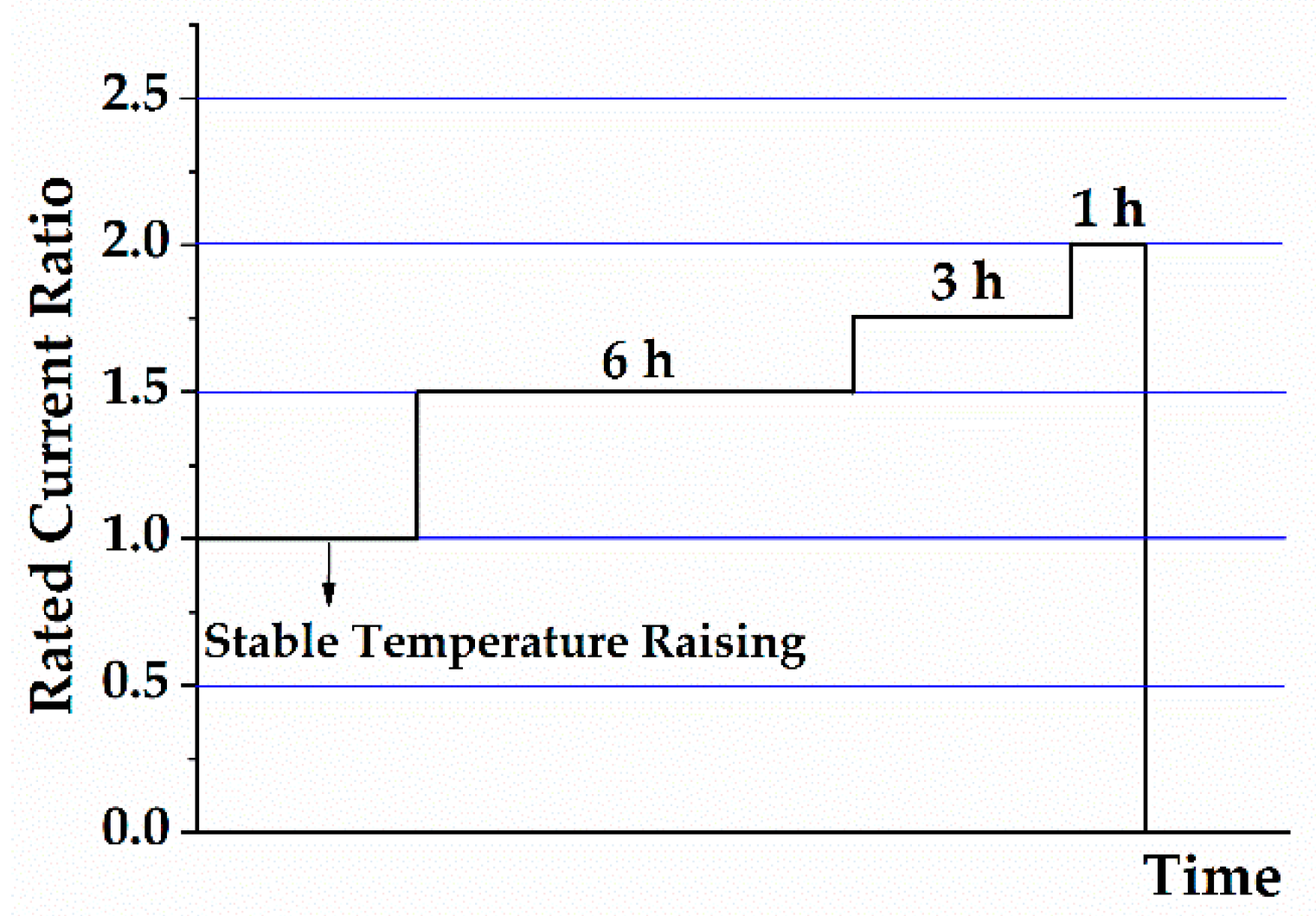

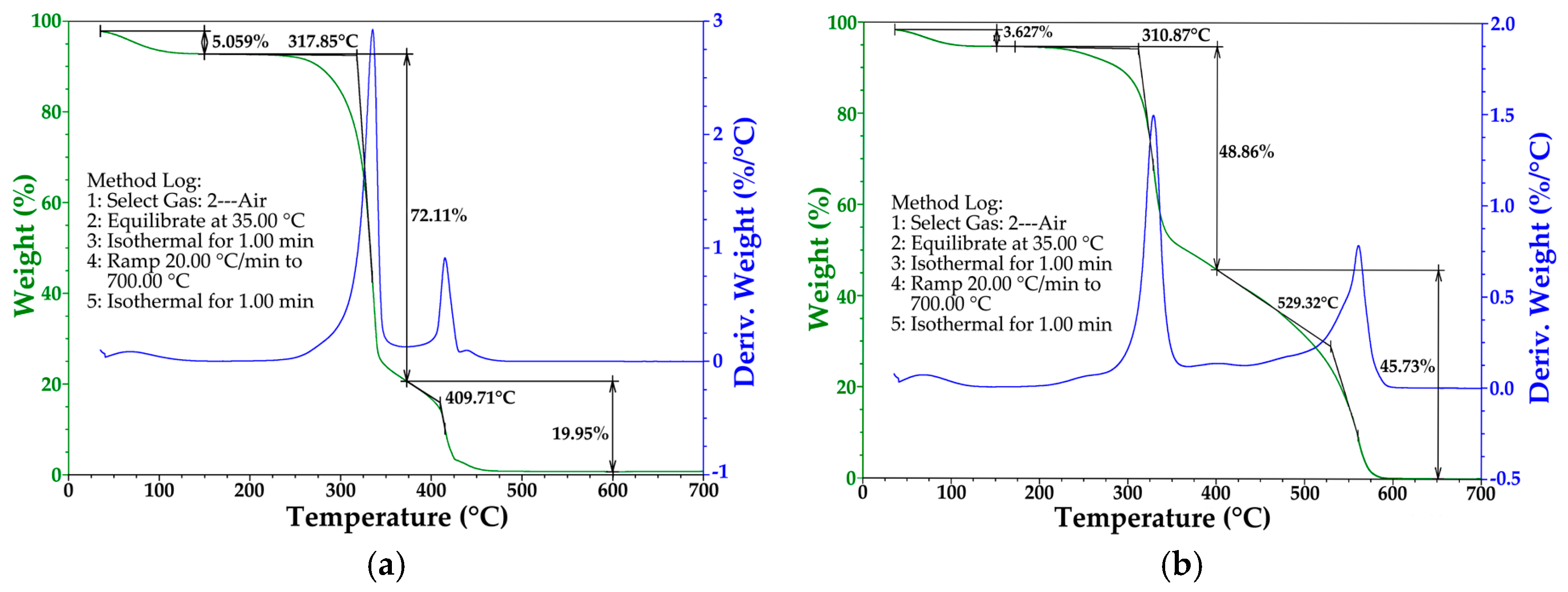
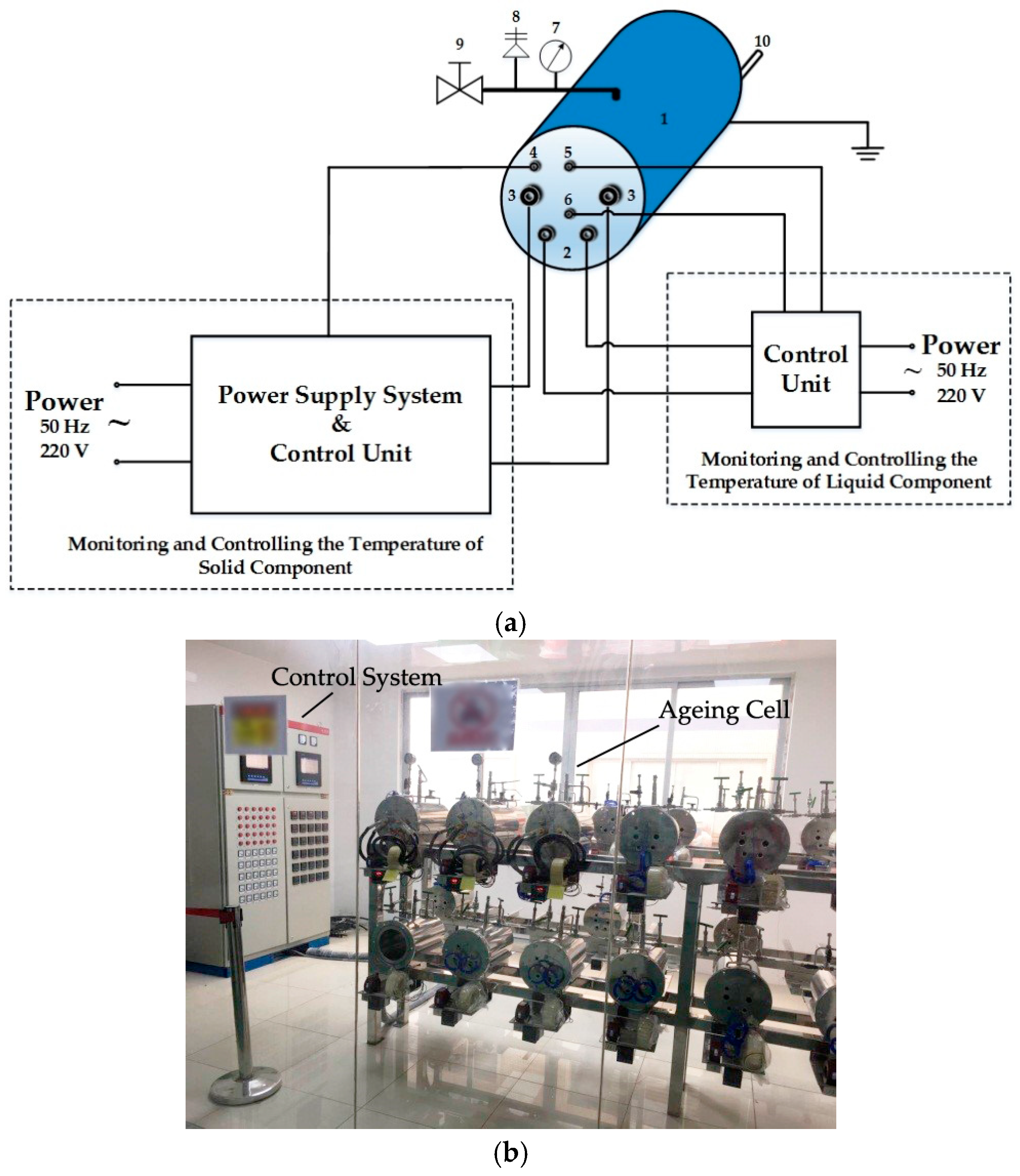
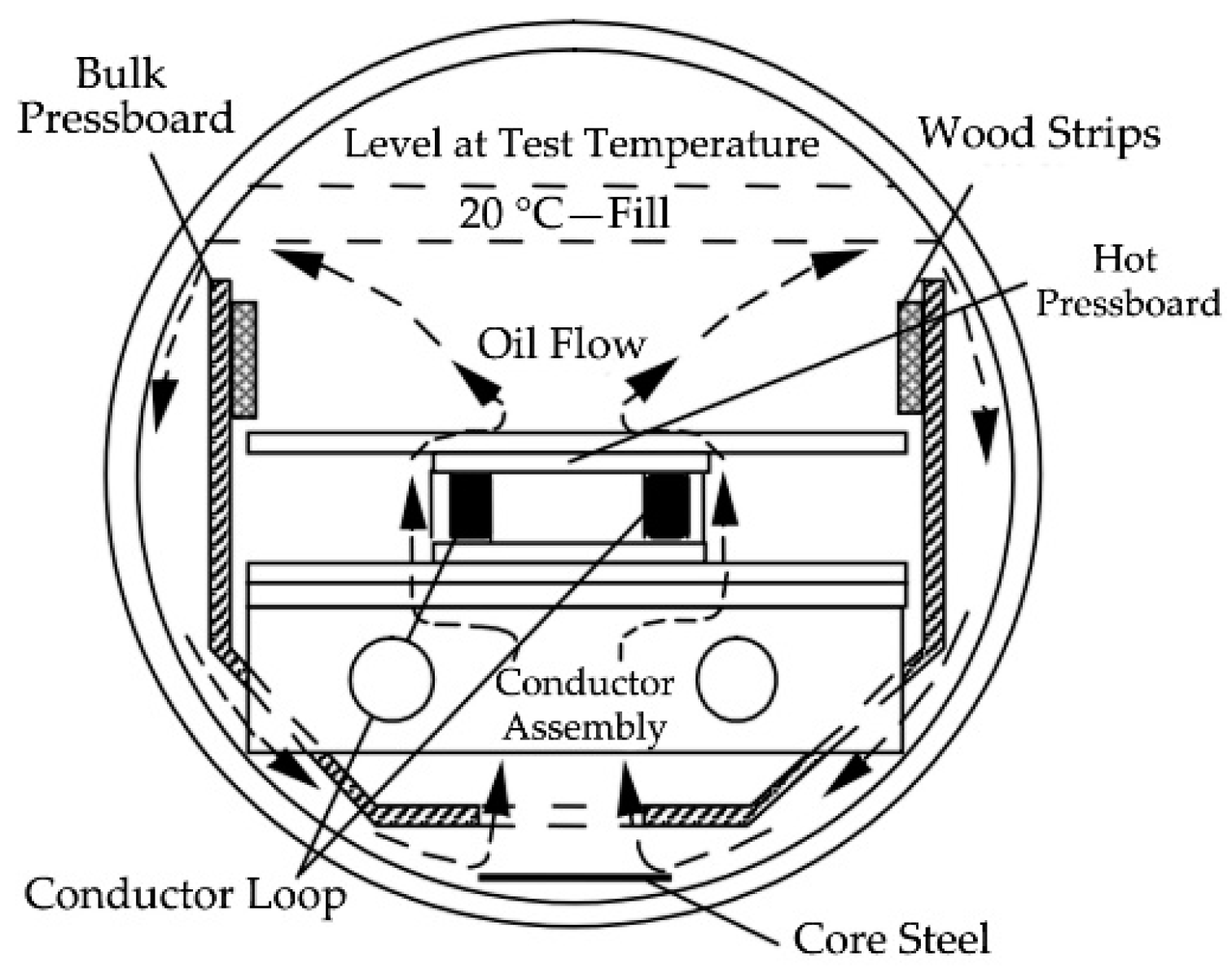
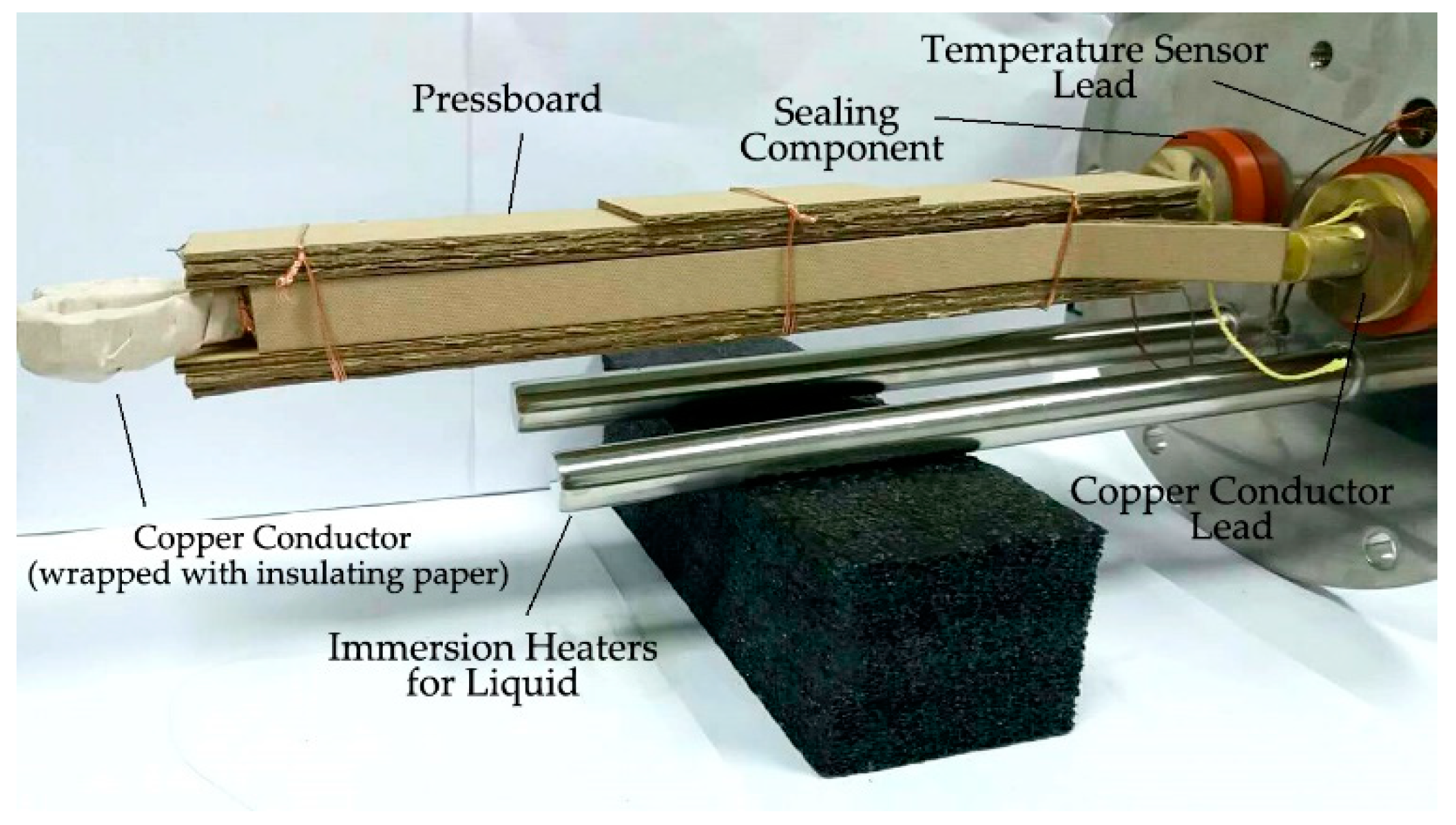
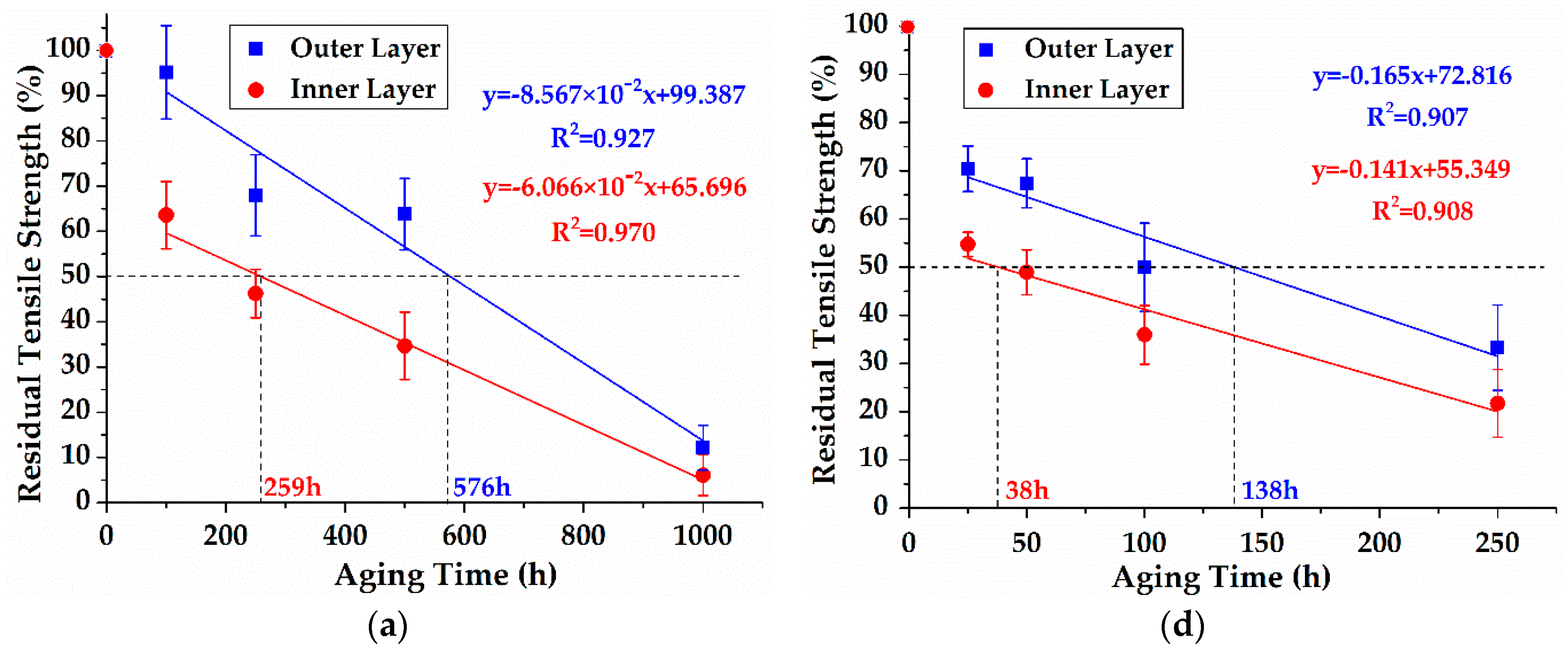

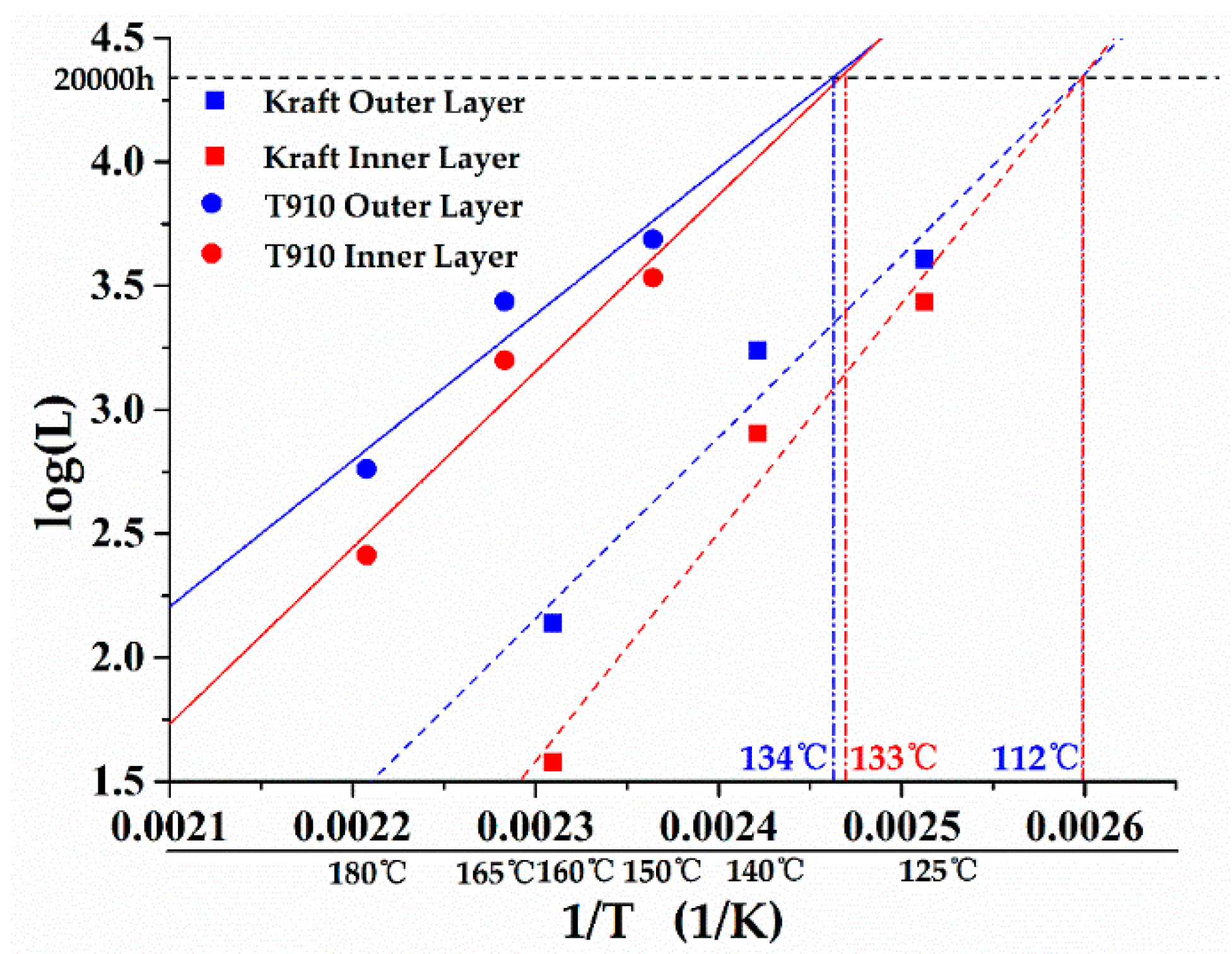
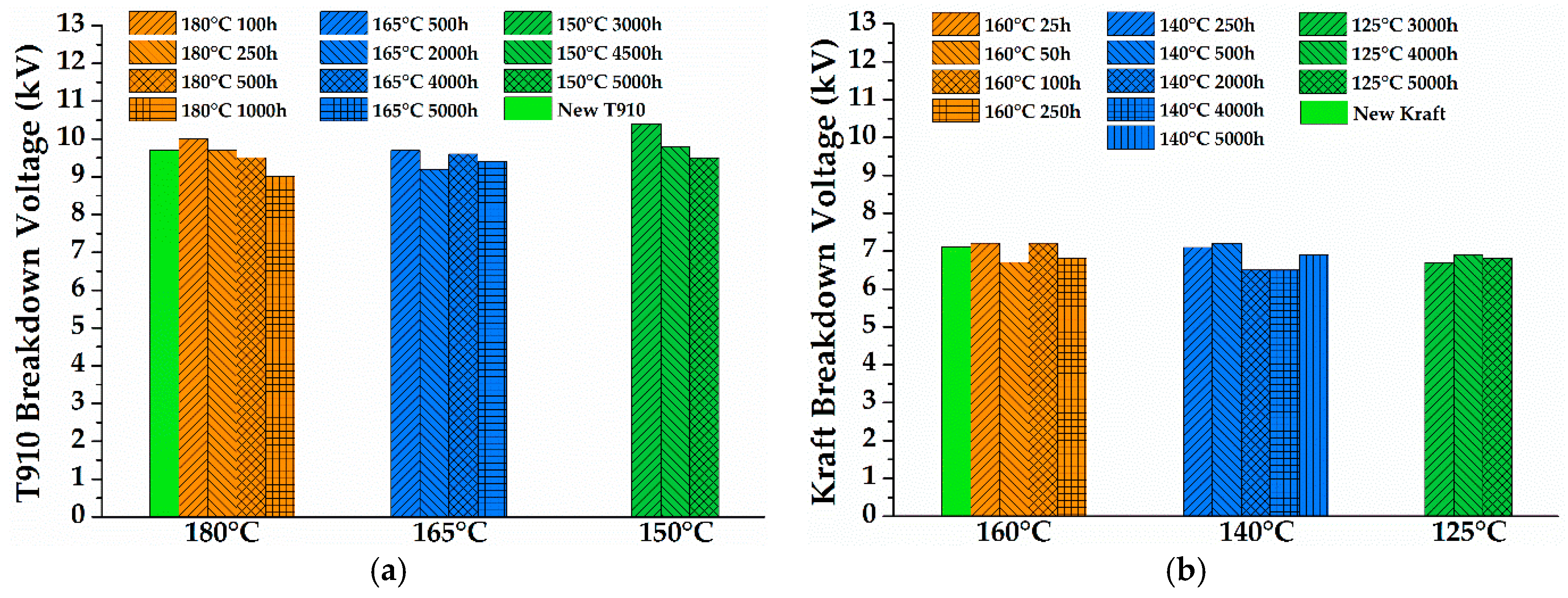
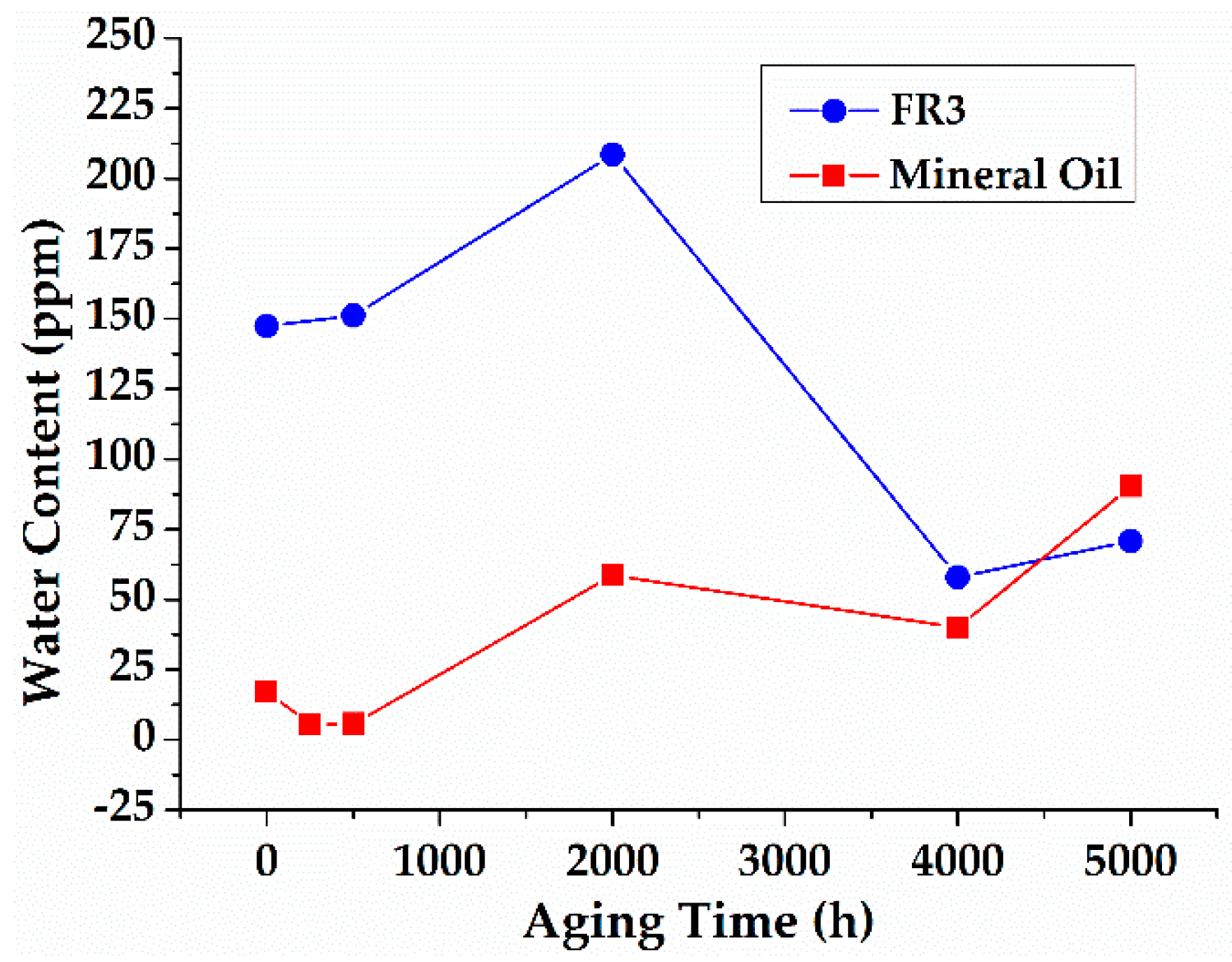

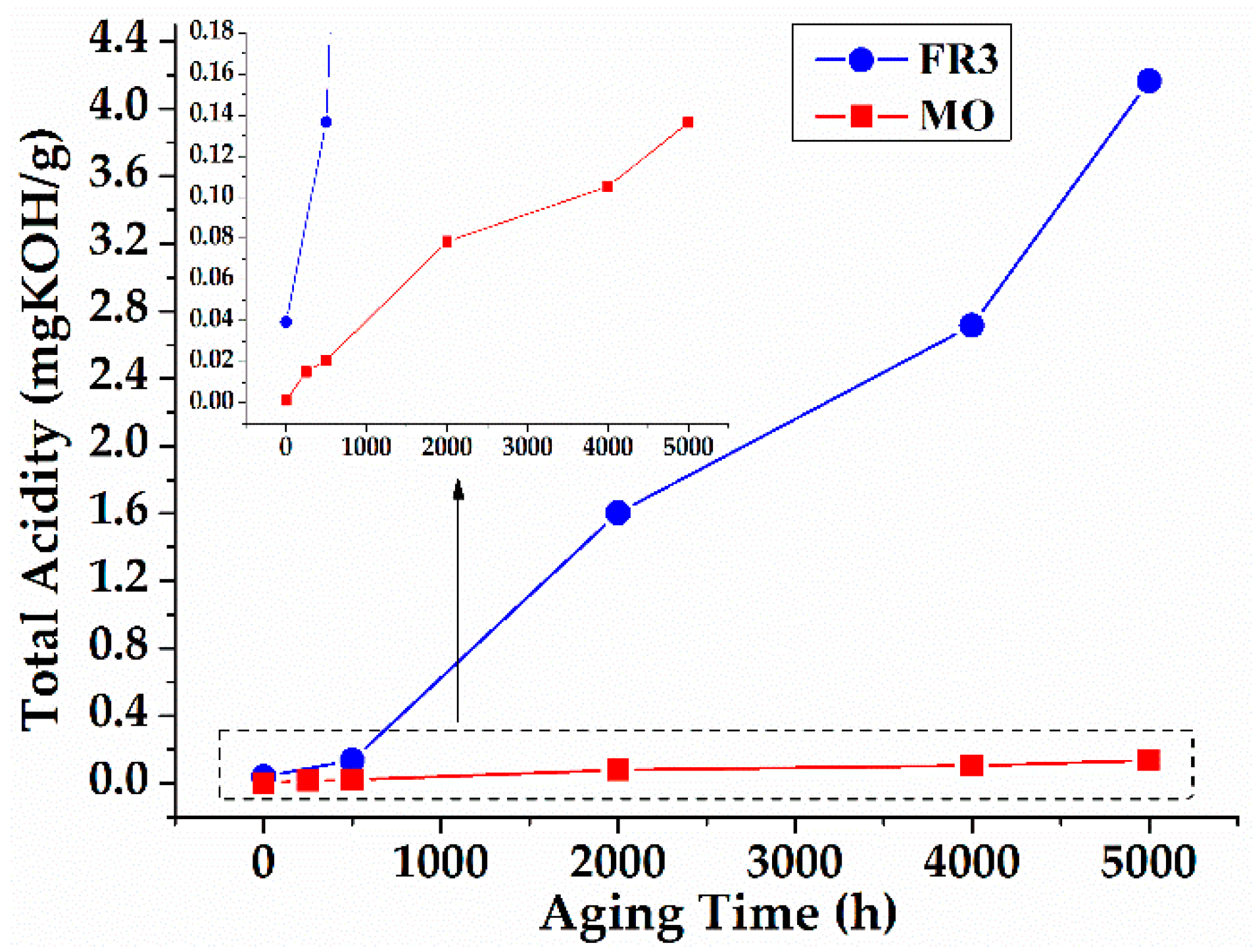

| Properties | Insulating Oil | Properties | Insulating Paper | ||
|---|---|---|---|---|---|
| MO | FR3 | Kraft | T910 | ||
| Appearance | Clear | Light Green | Thickness (mm) | 0.08 | 0.08 |
| Density, 20 °C, (g·cm−3) | 0.848 | 0.92 | Density, (g·cm−3) | 0.89 | 0.9–1.1 |
| Viscosity, 40 °C, (mm−2·s−1) | 8.01 | 32–34 | Tensile Strength, MD (N·cm−1) | 64.7 | 70 |
| Flash Point, PMCC (°C) | 155 | 255 | Tensile Strength, XD (N·cm−1) | 38.6 | 17 |
| Acid Value (mg KOH·g−1) | 0.0011 | 0.013–0.042 | AC Breakdown Voltage, Air (kV·mm−1) | 10.4 | 20 |
| Dissipation Factor (90 °C) | 0.00101 | 0.02 | Dissipation Factor (%) | 0.25 (50 Hz, 100 °C) | 1.6 (60 Hz, 90 °C) |
| Property | Insulating Oil | Insulating Paper | ||
|---|---|---|---|---|
| MO | FR3 | Kraft | T910 | |
| Water Content | 17.1 ppm | 147.4 ppm | 0.503% | 0.426% |
| Reference EIS (MO and Kraft) | Candidate EIS (FR3 and T910) | ||||||
|---|---|---|---|---|---|---|---|
| Temp. of Kraft (°C) | Temp. of Mineral Oil (°C) | Aging Cycle (h) | Temp. of T910 (°C) | Temp. of Natural Ester (°C) | Aging Cycle (h) | ||
| Surface | Center | Surface | Center | ||||
| 160 | 124 | 115 | 25/50/100/250 | 180 | 130 | 115 | 100/250/500/1000 |
| 140 | 122 | 115 | 250/500/2000/4000/5000 | 165 | 127 | 115 | 500/2000/4000/5000 |
| 125 | 121 | 115 | 3000/4500/5000 | 150 | 125 | 115 | 3000/4500/5000 |
| Life of Kraft (h) | 160 °C | 140 °C | 125 °C |
| Outer Layer | 138 | 1734 | 4044 |
| Inner Layer | 38 | 804 | 2718 |
| Life of T910 (h) | 180 °C | 165 °C | 150 °C |
| Outer Layer | 576 | 2735 | 4878 |
| Inner Layer | 259 | 1583 | 3408 |
© 2018 by the authors. Licensee MDPI, Basel, Switzerland. This article is an open access article distributed under the terms and conditions of the Creative Commons Attribution (CC BY) license (http://creativecommons.org/licenses/by/4.0/).
Share and Cite
Zhang, X.; Ren, L.; Yu, H.; Xu, Y.; Lei, Q.; Li, X.; Han, B. Dual-Temperature Evaluation of a High-Temperature Insulation System for Liquid-Immersed Transformer. Energies 2018, 11, 1957. https://doi.org/10.3390/en11081957
Zhang X, Ren L, Yu H, Xu Y, Lei Q, Li X, Han B. Dual-Temperature Evaluation of a High-Temperature Insulation System for Liquid-Immersed Transformer. Energies. 2018; 11(8):1957. https://doi.org/10.3390/en11081957
Chicago/Turabian StyleZhang, Xiaojing, Lu Ren, Haichuan Yu, Yang Xu, Qingquan Lei, Xin Li, and Baojia Han. 2018. "Dual-Temperature Evaluation of a High-Temperature Insulation System for Liquid-Immersed Transformer" Energies 11, no. 8: 1957. https://doi.org/10.3390/en11081957




